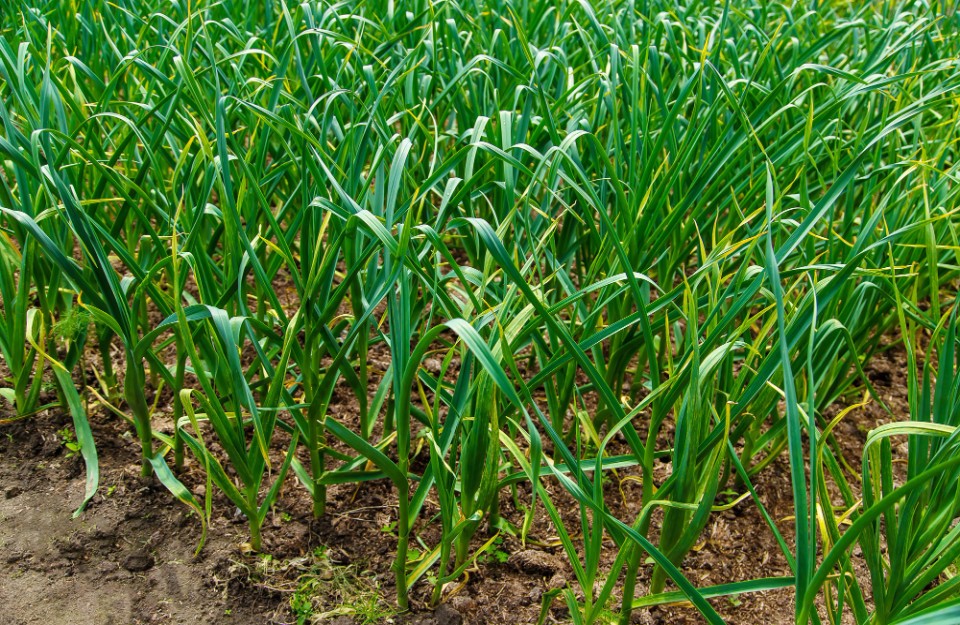
Garlic is a bulbous spice crop characterized by multiple cloves within a single bulb. It boasts a unique aroma and spicy taste attributed to its component called allicin. This versatile herb is utilized to alleviate throat and stomach-related ailments. Being a cash crop rich in essential nutrients, garlic finds its way into nearly all vegetable and meat-based cuisines, enhancing flavor profiles. Moreover, its antibacterial and anticancer properties render it effective in treating various diseases. It plays a significant role in generating foreign currency. In Madhya Pradesh, garlic cultivation spans across 60,000 hectares, covering districts such as Mandsaur, Neemuch, Ratlam, Dhar, and Ujjain.
Garlic flourishes in cooler climates but has limited tolerance for extreme heat and cold. Bulb formation is not optimal during excessive heat and long daylight hours, whereas shorter days are conducive. For a successful harvest, an ideal temperature range of 15-35 degrees Celsius and 70% humidity is recommended. Prolonged cultivation of garlic in lower temperatures, especially during the rainy season, may lead to the development of bulbils in the leaf axils, resulting in reduced bulb yield.
Farmers can generate substantial income by growing garlic during the monsoon season. While September-October is traditionally preferred for planting garlic, sowing during the monsoon months of June-July or August yields harvest-ready crops within four months. Selecting well-drained fields is essential to prevent waterlogging and ensure a successful yield. Employing appropriate cultivation techniques is vital for maximizing profitability.
For successful garlic cultivation, well-drained loamy soil with efficient water drainage is essential. Bulb development is hindered in compacted soil. The soil pH should ideally range between 5.5 to 7.5, providing a slightly acidic to neutral environment conducive for garlic growth. Deep plowing is necessary, accompanied by the addition of well-rotted manure to enhance the soil's organic content. Thorough plowing using a rotavator ensures a level field with beds and irrigation channels. Allowing the mixture to remain open in the soil for approximately two weeks facilitates decomposition. Garlic cultivation thrives in soil enriched with suitable organic matter.
Garlic sowing can be done between September and October. Planting is carried out using trenching or dibbling methods. Cloves should be buried in the soil at a depth of 5-6 cm and covered lightly with soil. Thin ends of garlic cloves should be placed facing upwards. During planting, cloves should be spaced 8 cm apart within rows and rows should be spaced 15 cm apart. The quantity of seeds required depends on the size of the garlic. Medium-sized garlic requires approximately 160-170 kilograms of seeds per acre.
Manure and Fertilizers: The quantity of manure and fertilizers depends on the fertility of the soil. Per hectare, approximately 20-25 tons of compost or cow dung or 6-8 tons of vermicompost, along with 100 kg of nitrogen, 50 kg of phosphorus, and 50 kg of potassium, are required. The first dose of fertilizer, approximately 30-35 days after planting, should include 1 bag of urea (45 kilograms), 5 kilograms of micronutrient fertilizer, and 5 kilograms of calcium nitrate per acre. The second dose, when the crop is 50-55 days old, should include 35 kilograms of urea and 5 kilograms of mycorrhizae per acre.
Garlic Irrigation: Drip irrigation enhances yield. Light irrigation is necessary post-sowing. Sprinkler irrigation suits garlic cultivation. Irrigation frequency should adapt to soil conditions, typically occurring every 10-12 days. Ensure gentle watering to prevent waterlogging. Garlic plants require around 600 to 700 millimeters of water annually, akin to yearly rainfall. On loamy or clayey soil, garlic should receive at least 1 inch of water weekly, while sandy soil may require up to 2 inches.
Weeding and Pest Control: To maintain root aeration, the first weeding should occur using a hoe or khurpi 25-30 days post-planting, followed by a second weeding 50-55 days later, promoting bulb development. For pest management, mix Pluchloralin with 500 liters of water at 1 kg per hectare before planting.
Control: Apply Captan Oxide at 2.5 grams per liter of water and Sendovit at 1 gram per liter of water twice at 15-day intervals for fungicide application.
Garlic Harvesting and Drying - Cease irrigation when the leaves turn yellow and begin to dry. Subsequently, allow the bulbs to air-dry for 3-4 days. Then, trim the leaves, leaving 2 to 2.25 cm of the stem attached to the bulbs. Store the bulbs in thin layers, bundled with their leaves.
Yield: The garlic yield varies depending on the variety, soil type, and crop management practices, ranging from 150 to 200 quintals per hectare.
Pests and Control: